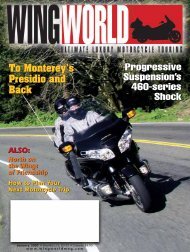to view pdf file of current issue - Wing World Magazine Archives
to view pdf file of current issue - Wing World Magazine Archives
to view pdf file of current issue - Wing World Magazine Archives
You also want an ePaper? Increase the reach of your titles
YUMPU automatically turns print PDFs into web optimized ePapers that Google loves.
W R E N C H I N G O N A C L A S S I C W I N G<br />
By Nick Hoppner<br />
How embarrassing! I’d just returned from a short ride<br />
on GWRRA’s GL1000. Because this old bike wasn’t<br />
expected <strong>to</strong> be ridden again for awhile, I had intended<br />
<strong>to</strong> empty the fuel out <strong>of</strong> the carbure<strong>to</strong>rs by running it dry,<br />
but I’d neglected <strong>to</strong> turn the fuel valve <strong>to</strong> OFF as I rode it <strong>to</strong><br />
the garage.<br />
So, after turning <strong>of</strong>f the fuel valve, I sat on the bike and ran the<br />
engine for awhile. It <strong>to</strong>ok longer than I thought it would <strong>to</strong> exhaust the<br />
gas in the carbs, and everything seemed fine—until suddenly the old<br />
horse <strong>to</strong>ok a leak. If you’ve ever been horseback riding and this happens,<br />
you know what I mean about embarrassing. Suddenly steaming<br />
radia<strong>to</strong>r fluid was gushing out between my boots, acrid steam rising<br />
around me.<br />
Obviously the bike had overheated, and the cause was simple. Its<br />
32-year-old thermostatic switch had failed, so the cooling fan didn’t<br />
come on <strong>to</strong> force cool air over the radia<strong>to</strong>r.With no cooling air <strong>to</strong> flow<br />
over the radia<strong>to</strong>r, the coolant boiled inside the radia<strong>to</strong>r, backed up<br />
through the overflow tank and spewed out through the drain hose<br />
under the bike.Time <strong>to</strong> install a new thermostatic switch.<br />
I called Metro Mo<strong>to</strong>rsports in Glendale, Arizona.Wonder <strong>of</strong> wonders,<br />
they had one in s<strong>to</strong>ck—complete with an O-ring in place! I paid<br />
the $87.79 and rode the old girl out <strong>to</strong> Stu Oltman’s for the change-out.<br />
After letting the bike cool for awhile, and with the bike on its centerstand,<br />
Stu put a clean catch basin under the bike and removed the<br />
radia<strong>to</strong>r drain plug. A slow stream doubled in volume when he then<br />
opened the false fuel tank and removed the radia<strong>to</strong>r cap. Soon the radia<strong>to</strong>r<br />
was empty. He reinstalled the drain plug at this time.<br />
To gain access <strong>to</strong> the thermostatic switch, he removed the horn,<br />
tucking it out <strong>of</strong> the way, then unplugged the radia<strong>to</strong>r fan.<br />
Next, he reached in<strong>to</strong> the narrow space between the engine and<br />
the radia<strong>to</strong>r fan and unplugged the two prong connec<strong>to</strong>rs <strong>of</strong> the thermostatic<br />
switch. Stu uses some long-shaft, curve-tipped pliers for this.<br />
As is <strong>of</strong>ten the case, when a mechanic has the right <strong>to</strong>ols at hand, the<br />
job goes much more smoothly.<br />
This was born out again as he unwrapped the new thermostatic<br />
switch. Going <strong>to</strong> his <strong>to</strong>olbox, he found a 27mm socket that perfectly fit<br />
the switch. How many shade tree mechanics would have a 27mm socket<br />
Probably not <strong>to</strong>o many.<br />
Reaching in<strong>to</strong> the bike, he slipped the socket over the dome <strong>of</strong> the<br />
old switch, then inserted a long-shafted, wobble-end socket wrench<br />
in<strong>to</strong> the socket and turned it.The old part unscrewed as easily as if it<br />
had been installed a week ago, its O-ring compressed by a long-forgotten<br />
Japanese assembly line worker over three decades ago.<br />
The new thermostatic switch is a bit longer than the old part, but<br />
Stu loosens the drain plug using a 14mm socket before<br />
moving the catch basin (background) underneath the bike.<br />
Draining the coolant.<br />
78 <strong>Wing</strong> <strong>World</strong>

















